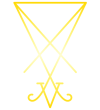Sabbats and Esbats
Sabbats differ from Esbats [meetings during the full Moon cycle] in that they are also celebrations. Sabbats comes from the French word s'ebattre, meaning “to revel” or “frolic.” For the Greater Sabbats of the year, see Holidays.
A Coven needs the following to operate:
- A secure and safe area that will serve as a Temple, where the coven can get reasonably noisy yet not be disturbed in any way. The area should be blessed and consecrated by the High Priest/ess. Sigils should be placed or painted on the walls, along with images of Zeus. If this is not possible, any place that is safe, secure, and private is acceptable. The space must be consecrated and dedicated to Zeus before meetings take place.
-
Ritual Tools for the Coven:
The High Priest/ess can bring his/her own athame, or there can be ritual tools that belong to the coven as a group. These include an altar, group chalice, bell, candles, and an incense burner, preferably one on a chain for burning loose incense over coals. This is used to consecrate the circle and the temple. A book for prayers and words of power for the group is also needed; these can be written by the most artistic person in the coven. All items should be kept secure and not handled by outsiders. The coven’s special insignia should be painted, drawn, or engraved on each of the ritual tools.
[Please see note at the bottom of the page.] - Musical instruments are optional but encouraged. Traditional instruments for a coven include small drums, tambourines, recorders, panpipes, flutes, and rattles. These are used for rhythmic dancing in a circle or snake-like line formation to raise energy as a group. These are simply traditional guidelines; music can also be played over stereo speakers (e.g., metal music to energize the group). Whatever works and feels right for the coven is acceptable.
Regular coven meetings are Esbats. Rituals, magick, and group study are conducted during these meetings. Esbats are held during the full moon cycle. The reason for this timing is that the powers of the female side of the soul are much stronger during the full moon. The female side is the source of raw power; the male side is logical and directs that energy into manifestation. The full moon enhances all magickal workings. Every coven should meet at least once a month during the full moon cycle. With 13 lunations per year, this means a minimum of 13 meetings annually.
At Esbats, any work to be done, how it will be done, and planning for the next Esbat are discussed. The coven collectively determines what magickal work will be done and how. The entire group should then meditate on the full picture of the intended working. Every member must hold a clear image in their mind of the working and its end result.
In a coven, all members should actively participate. One lights the candles, others play musical instruments, another writes the prayers or helps structure the ritual, and so on.
Privacy is absolutely critical. The group must not be disturbed or interrupted, especially during magick. Security is paramount. For magickal workings, the following ritual takes place (these are general guidelines and can be adjusted based on the group’s preferences):
The Esbat is typically opened by the High Priest/ess drawing a pentagram in the air and performing the Standard Ritual. After invoking the Four Primary Powers, the High Priest/ess reads a prayer asking Zeus for guidance.
Five minutes of meditative silence follow, allowing each person to give thanks to the Powers of Hell or make personal requests.
Then, the group chants together:
Z-E-U-S, Z-E-U-S
(or variations like Z-E-U-S — H-E-A-R — U-S).
Instruments such as a recorder or small drum can be played during this. Feel and enjoy the energy of the chant for several minutes.
After chanting, the High Priest/ess stands with legs apart, arms raised. The rest of the group kneels and raises their arms.
At this point, the High Priest/ess opens to any Demonic energies present. Occasionally, a Demon may speak to the coven through the High Priest/ess.
When magickal workings are to be performed, a circle is cast. A coven member lights four black (or blue if black is unavailable) candles at each cardinal point to represent the Four Primary Powers. This circle concentrates the coven’s power.
- Direct your energy through the athame, visualizing a blue light outlining the circle.
- The circle must be large enough to comfortably contain everyone.
- Breathe in energy, and on the exhale, channel it through the athame into the circle.
- A censer containing appropriate incense is used to consecrate the circle.
- The High Priest/ess then goes around the circle again with the athame to reinforce it.
- Background candles can be added to suit the working’s intent (e.g., red for destruction or lust). Always place candles safely and away from flammable objects.
No one may leave the circle during the working. The circle must not be broken. Privacy and security are again critical.
All members must direct their combined will toward the same goal. The power builds in a cone shape above the circle. Once enough power is raised, it is directed.
Dancing and chanting are ancient and effective ways to build energy. The group dances in a circle to a regular rhythm or chant. The beat quickens, the energy builds. Dancing should be widdershins (counterclockwise). Just let go and enjoy it.
- Dances begin slowly and build to a climax.
- Dancers may hold hands or move individually.
- Holding hands (or linking elbows) helps concentrate the power and builds it more evenly.
- Dancing can be done robed or nude.
Important elements: simplicity and rhythm. Everyone faces inward, stepping left-right-left, bending knees slightly for rhythm. Stomping in time with the beat helps build power.
The coven will decide in advance which chants, instruments, and ritual wording to use. Everyone must be clear on their roles and on what the ritual aims to achieve.
Feeling is the most important component of magick. To generate power, every member must feel strongly about the goal. Each person must hold a vivid image of the end result in mind. That visualization is what channels the energy. All energy must be focused on that final outcome.
The goal is to build power to its peak and release it. Chant faster, dance faster. When the climax hits, stop dancing, drop to the ground (knees or however is comfortable), and release. Shouting also helps release the energy.
For optimal timing, see “Timing.”
The ritual concludes with the High Priest/ess ringing the bell, whose symbolic meaning is reverberation; the words of power resonating into the soul.
Afterward, feasting is customary. Each member can bring food or drink. There can also be dancing, fun, and games. Sabbat-like festivities should be planned into the event.
For meetings where no magick is performed, a standard ritual and invocation of Zeus should be done, asking for guidance. These gatherings are also for developing personal powers. The group can do energy work together. The High Priest/ess may read a text, followed by group discussion. Topics should be focused on Zevism, magickal practice, and personal empowerment.
NOTE:
The deeper purpose of a coven is the meeting of minds and spiritual energy. Ritual tools are nothing more than props. If your group cannot obtain them, that does not prevent you from forming a coven and working together. Formal ceremony is ideal but not essential. Teenagers or others living in dangerous or restrictive environments can still function without physical items. Zevism is about harnessing the power of your mind and soul; material items are secondary.

 አማርኛ
አማርኛ العربية
العربية বাংলা
বাংলা Български
Български 中文
中文 Čeština
Čeština Dansk
Dansk Deutsch
Deutsch Eesti
Eesti Ελληνικά
Ελληνικά Español
Español Français
Français हिन्दी
हिन्दी Hrvatski
Hrvatski IsiZulu
IsiZulu Italiano
Italiano 日本語
日本語 Kiswahili
Kiswahili Magyar
Magyar Македонски
Македонски नेपाली
नेपाली Nederlands
Nederlands فارسی
فارسی Polski
Polski Português
Português Română
Română Русский
Русский Slovenščina
Slovenščina Suomi
Suomi Svenska
Svenska Tagalog
Tagalog Türkçe
Türkçe